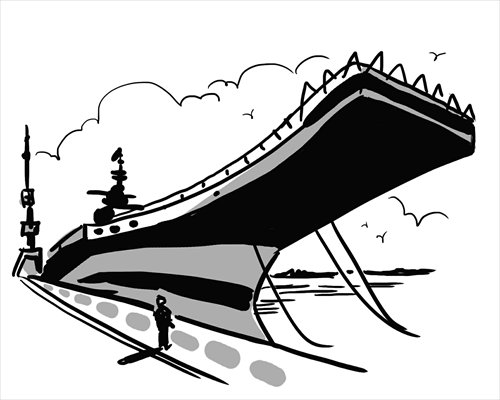 |
| Illustration: Liu Rui/GT |
After a delay of nearly five years, India's first indigenous aircraft carrier, the INS Vikrant, was finally launched on August 12 from the Cochin Shipyard, making India the fifth country in the world capable of launching an indigenous carrier. There are plans for two more Indian carriers in the next few years.
Tasked with securing a long coastline and providing security for the Indian Ocean region, India requires at least three aircraft carriers to fulfill this role.
One carrier needs to be positioned on the western seaboard, the second one on the eastern side, with the last being kept as reserve or deployed in the south.
However, it must be understood that carriers, even though they are potent instruments of maritime power projection and forward command platforms equipped with air power, are vulnerable individually and too precious to be operating alone.
They normally are surrounded and protected by "screening units" comprising different types of ships and submarines moving as a composite unit called a Carrier Battle Group (CBG).Thus it is not enough to acquire the glamorous carriers: getting other units to comprise a robust CBG is equally important.
Unfortunately, at no point of time since independence has the Indian navy ever had three carriers, even though four fleet carriers and two light carriers were envisaged. There have been large gaps in India's maritime security calculus and between aspirations and reality.
In the initial years, India purchased the INS Vikrant (formerly the HMS Hercules), a Majestic class carrier, from the UK in 1957. Commissioned on March 4, 1961, the original Vikrant was finally decommissioned in 1997.
The second acquisition, INS Viraat, a Centaur class 28,700 tons aircraft carrier, was purchased in April 1986 after many offers were considered, and it is still in operational usage.
Bean-counting comparisons by the media between the PLA Navy carrier Liaoning and the new Vikrant or the scheduled Vikramaditya (formerly the Gorshkov) have been rising.
Although the fact that the two navies have been cooperating on anti-piracy issues off the Horn of Africa and face common maritime challenges, the media is intent on unfairly pitting one against the other.
Until recently, China was the only permanent member of the UN Security Council without an aircraft carrier. It must be realized that both navies, Indian and Chinese, have evolved from different traditions, and share a different heritage and national priorities.
Both have suffered due to "sea blindness" at the hands of continentally inclined policymakers, but have undergone a paradigm shift recently and are modernizing themselves.
It is futile to make mere technical comparisons between the two carriers.
The comparison lies more in the mindsets, training, tactics, and the likely roles that they are expected to play.
To prepare for carrier operations, the PLA Navy had been readying itself in many ways including training its pilots on the decommissioned Melbourne. In addition, it had reportedly used a concrete mock-up of a carrier flight deck near Wuhan for training carrier pilots.
The Brazilian navy has reportedly been willing to cooperate with the Chinese navy for mutual benefit.
Yet it must be realized that India has been using carriers since the early 1960s, and has, after considerable trial and error, mastered the operating procedures and complex associated tactics. This requires time and effort for which there are no quick fixes.
After overcoming initial teething equipment issues, the PLA Navy will have to slowly master the tactics and train accordingly for optimal utilization, which would require years.
Designing a carrier is a herculean task. The Indians have launched their first carrier and are working on a second, while the Chinese have yet to launch an indigenous carrier. The Chinese are still way behind.
India and China should focus on maritime commonalities and challenges rather than incongruence.
After all, the sea unites while the land divides.
 PLA's integrated battle group in live-fire drill
PLA's integrated battle group in live-fire drill Egypt's clashes kill 525 so far
Egypt's clashes kill 525 so far Phubbers turn social etiquette on its head
Phubbers turn social etiquette on its head Jaguar Land Rover to recall 11,852 cars
Jaguar Land Rover to recall 11,852 cars Men's triple jump at IAAF World Athletics Championships
Men's triple jump at IAAF World Athletics Championships Christy Chung on 'COSMO' with lovely daughters
Christy Chung on 'COSMO' with lovely daughtersDay|Week|Month